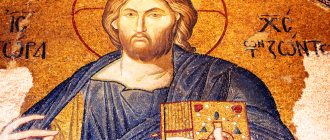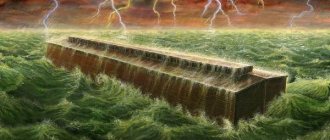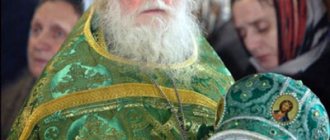For all people who revere the Bible, the Ark of the Covenant, or Testimony, of Revelation is the greatest shrine. According to the Bible, stone tablets with the Ten Commandments were kept in it. The same source mentions that the Ark, during the exodus of the Jews from Egypt, was located in the Holy of Holies of the Jerusalem Temple. The Bible describes its appearance in detail.
Appearance of the Ark: biblical description
The Old Testament describes the Ark as follows. It was made of shittim wood, covered with gold inside and out, and had a golden crown on top.
The shittim tree spoken of in Scripture is a durable species of acacia that grew around the Red Sea in the desert.
The Bible also says that the Ark was 1.5 cubits in height and width and 2.5 in length. 44.4 cm is equal to an Egyptian small cubit, therefore, the length of the Ark was 111 cm, and the width and height were 66.6 cm.
Cover with the image of two cherubs
The ark was covered on top with a golden lid. Its length was 2.5 cubits, and its width was 1.5. On the top of the lid were images of two cherubim, cast in gold, facing each other, with wings covering the Ark, which was the most important evidence of the Bible - a visible reminder of the Covenant (the union concluded between the people of Israel and God).
The Lord promised Moses above the lid of the Ark to appear in a cloud and speak between two cherubim. A special power emanating from the Creator is associated with the Ark. This power is the Divine presence, Shekinah. The Lord communicated with Moses over him, informing him of the commandments for the Israelites. Below is the Ark of the Covenant (photo of one of the copies).
Italy invades Ethiopia and begins search
Italy in the early 20th century considered Ethiopia its sphere of influence. Ethiopia remained one of the few African countries that managed to maintain independence from European powers. Clashes between Italy and Ethiopia have occurred in the past and ended in victory for the latter. A major battle took place in 1896 when 14,500 Italian soldiers were defeated by 80,000 Ethiopians at Adua. Driven by a desire to colonize the country, Mussolini sent new mechanized legions under the command of Field Marshal Rodolfo Graziani across the Abyssinian border from Italian Somalia and Eritrea on October 3, 1935.
How was the shrine kept?
Only the high priest was allowed to approach the Ark and only once a year, more precisely, on Yom Kippur. It could be carried on the shoulders of the Levitical monks. This shrine was securely hidden from human gaze, since it was dangerous for an ordinary person to look at it.
The history of the Ark of the Covenant is marked by the fact that on the way to the Holy Land, the people of Israel moved from place to place, led by God. Moses cried before setting out with the Ark: “Arise, O Lord, and Thy enemies will be scattered.” When the people, built in “militia” and “camps,” stopped, Moses said: “Come back, Lord...”.
When the Israelites entered the Promised Land, the Ark was transferred from one settlement to another several times. He was first at Mount Ebal, in the camp of the Jews, and then in Shiloh and Beth-El. The shrine was captured in a battle near the city of Mizpah by the Philistines. However, disasters befell the cities to which the Ark was transported. Therefore, the Philistines had no choice but to return the shrine to the Jews. King David, after his conquest of Jerusalem, decided to transport her to the new capital of Israel. However, at first the Ark stood for three months in the house of one Levite. In Jerusalem, King David built a new tabernacle - a tent in which the relic was placed.
The king also planned to build a temple for her, but the Lord did not allow him to do this. Solomon, the son of David, nevertheless built the cathedral. The Ark was installed in its holy of holies. Solomon, according to aggadic legend, provided in advance in the basements of the temple a special hiding place where the sacred relic could be hidden, which the prophet Jeremiah hid.
Biblical biography
Arriving in the region of Canaan, which stretched from the Jordan River to the Mediterranean Sea, the Jews perceived it as the Promised Land they had been promised and began to conquer it. The process dragged on for years, during which the Ark was kept in temporary capitals - first in Gilgal (opposite Jericho), and then in Bethel (modern Bethel). When the Jewish kingdom was more or less established, the shrine was placed in Shiloh (Shilo), where it remained for 369 years. Sometimes, when starting some particularly important and dangerous military campaign, the commander took the Ark with him, of course, with all the required solemn ceremonies. During the time of the high priest Elijah (Eli), the decline of the state began, which was associated both with internal strife and with the invasion of the Philistine tribe, known for their belligerence. In biblical traditions, the disasters that befell the “chosen people” are also linked to the wickedness of the sons of the high priest, Hophni and Phinehas, who were the guardians of the Ark. Elijah himself, apparently, was dissatisfied with his offspring, since he was preparing the orphan Samuel, whom he raised, to be his successor. The young man seemed to have foreseen the coming troubles and told his teacher about his visions, who reacted with sad sighs. These prophecies were fulfilled after the Battle of Aphek, in which the Jews were defeated and the sons of the high priest died. Elijah, hearing the sad news, fell from his throne and died. The Philistines took the captured Ark to the temple of the god Dagon, in which lightning began to blaze and various disasters began to occur. Out of harm's way, the Ark was returned to the Jews, adding a fair amount of gold to it. But by that time the representatives of the “chosen people” had already forgotten how to respectfully treat the shrine. Residents of the city of Beit Shemesh, where he was kept, looked at him without respect, as a result of which the city was devastated by some kind of epidemic, similar in description to the bubonic plague. Fortunately, the prophet Samuel put things in order, and a normal sanctuary was organized for the Ark in the house of Eleazar, who became the new custodian for 20 years. King Saul restored the kingdom of Israel, and his successor David captured Jerusalem, which became the new capital. A permanent tabernacle was built for the shrine, after which they organized the transportation of the Ark from the house of the then keeper Uzzah, who lived in Kirjath-jearim.
Mount Nebo
The Second Book of Maccabees says that, guided by the command of the Lord, the prophet Jeremiah hid the Ark on Mount Nebo. According to this source, the prophet, in obedience to Divine revelation, commanded the tabernacle to follow him as he climbed the mountain from which Moses had seen the inheritance of God. Jeremiah, having arrived there, discovered a dwelling in a cave and brought in the shrine, the tabernacle and the altar, after which he blocked the entrance. When some of those accompanying him later came to find the door, they could not notice it. After Jeremiah found out about this, he said, reproaching them, that this place would remain unknown until God gathered a crowd of people, having mercy. Then His glory will appear and a cloud will appear, as happened once with Moses.
Mount Nebo is one of the most important places where the events of the Bible took place. It is located near the Dead Sea, its northern tip, to the east of it. The mountain is located at an altitude of 817 m above sea level. It is located in what is now Jordan.
The Book of Deuteronomy (Old Testament) tells about the last day of the life of the prophet Moses. At the behest of God, he ascended this mountain to look at the Promised Land, on which the Lord never allowed him to settle. Moses died here, as mentioned in the Bible.
The Ark of the Covenant was not discovered on Mount Nebo, but traces of later buildings were still preserved. These are the ruins of a church that was erected at the end of the 4th century on the site where Moses supposedly died, as well as the remains of a monastery attributed by historians to the 4th - 6th centuries.
Axum City - Possible Location
Another authoritative source testifies that in the city of Axum, in the Cathedral of the Most Holy Virgin Mary of Zion, the Ark of the Covenant is guarded by local priests. A photo of this cathedral is presented below (it is located in the foreground of the photo, and behind it is the chapel).
The sanctuary was erected in the 4th century, but was rebuilt many times. Here the rulers of Ethiopia have accepted the crown for many centuries in a row. The current church was built by Haile Selassie in the 50s of the last century. His wife ordered the construction of a tiny chapel on the territory of the cathedral. It was conceived as the last place where the Ark of the Covenant could be kept. In fact, the chapel was built around a sacred relic. There is a narrow passage in it that does not allow the Ark to be taken out. Only one Guardian sees him. He spends his entire life inside the quarter-acre fenced area that surrounds the chapel, and no one but him is ever allowed to see the Ark.
Every Ethiopian temple has copies of the relic. Every year they are put on public display during a church holiday. The Glory of Kings, a 14th-century literary source, tells how the Ark arrived in Ethiopia. According to him, Bayna Legkem, the son of Solomon and Makeda, Queen of Sheba, who later became King Menelik, as well as the founder of the Negus dynasty, secretly transferred the Ark to this country, to one of the temples of its former capital - Aksum.
However, this is not the only version of how the shrine ended up in Ethiopia. There is an opinion that the Ark was carried out by cohens (church priests) from the temple. This happened during the reign of Manasseh. The Cohens were afraid that this king might desecrate the Ark, and they took it away. And they had something to fear: Manasseh installed idols in prayer houses and fell into worshiping them, imitating the cruel bloody cults of the Middle East, which included, among other things, human sacrifices. He departed from the clear and simple commandments of the Torah, even establishing altars dedicated to Ashtoreth and Baal - pagan deities, as well as heavenly bodies in the Temple of the Lord, the holiest place in all of Israel.
This overwhelmed the patience of the local priests, and they carried the Ark to Egypt from the desecrated temple. Here he found himself on the island of Yves, better known as Elephantine. A new temple was built on this site, in which the Ark remained for the next 200 years. However, then this cathedral was destroyed. The Ark eventually ended up on the island of Tana Kirkos in Ethiopia. It was installed, as in the distant times of the Jews’ wanderings in the desert, in a tent and served for eight years as an object of worship. The Ark was transferred after the conversion of the Ethiopian king to Christianity to the cathedral located in Axum (Holy Virgin Mary of Zion). A photo of the cathedral is presented below. According to another version, the Ark of the Covenant was found and kept in a secret place. Here he must remain until the temple is restored in Jerusalem.
The ark symbolizes the aron-ha-kodesh in synagogues - the cabinet in which the Torah scrolls are located. A similar personification of the sacred casket in Christian churches are tabernacles, which are usually located in the altar. They contain the Blood and Body of Christ, symbols of the New Testament with man's faith in God. The Apocalypse of John the Evangelist, the biblical Revelation, says that the Ark of the Covenant will return when the second coming begins.
Information about the Ark from Islamic sources
We also receive equally valuable information about this shrine from Islamic books. The Koran indicates that the stone tablets of the Testament given by Allah, which Moses brought from Mount Sinai, were kept in the Ark; in addition, the rod of Moses and the miter of the prophet Aaron were located in it. Muslims call this shrine “Tabut Sakina”, that is, “Repository of Grace”. During the wars, as the Koran tells, this Ark was lost by the Israelis.
The Muslims knew that Nebuchadnezzar, the Babylonian king, had made a campaign against the Jews and conquered Jerusalem after a difficult battle. The local people were captured and the city was destroyed. Muslims also knew that after forty years the Jews returned from Babylonian captivity and restored the temple. And yet the hall in which the Ark of the Covenant was located was empty.
Where did he disappear according to the Muslims? The followers of Muhammad have the answer to this question. As is known, the sacred texts of this religion include, in addition to the Koran, also hadiths. These are authentic sayings of the Prophet Muhammad, the founder of the Islamic religion. According to them, the Ark of the Covenant was found in the territory of modern Turkey. He is hidden in the city of Antakya, near the border with Syria. He could only get here with the Essenes, followers of another religious movement.
The Essenes were a community of Jews who existed at the turn of the Common Era and were in opposition to the Pharisees who dominated Jerusalem at the time. They left the city soon after in 70 AD. it was captured by the Romans. The Essenes settled near the Dead Sea, on its northwestern coast, in the Qumran caves. Here they copied and preserved the Torah. These texts were found in the mid-twentieth century. Another group of Essenes settled in the Antakya area. They carefully preserved the greatest shrine they brought with them, cutting off any contact with the world. The area where Antakya was located was rich in caves. The Essenes could have safely hidden the shrine in one of them, where the Ark of the Covenant is now located. Surah “The Cave” (in the Koran) talks about seven believing young men who took refuge from the godless ruler, their persecutor, in a cave. According to Koranic experts, it was located in Antakya. It is possible that the Ark of the Covenant of the Lord is kept here to this day, awaiting its time.
According to the teachings of Islam, the shrine will be rediscovered at the end of time, when all humanity begins to live according to the Koran. This event will mean that the coming of the Mahdi (Messiah) is near. He will establish a just government on earth, a kingdom of the Lord's commandments and morality.
It should be noted that Muslim views on this issue are remarkably similar to those of Christians and Jews. Thus, the latter believe that the Ark will be found with the arrival of Moshiach (Messiah), sent by God. Christians are convinced that it will be discovered before the second coming of Christ.
Historical records indicating where the Ark of the Covenant is located
The location of this shrine today is unknown. After 70 AD, traces of the Ark are lost. The last mention of him in historical sources dates back to this time. Titus, the Roman emperor who destroyed Jerusalem and burned the Temple of Solomon, according to this information, discovered a secret room there that contained the Ark of the New Testament. He took it to Rome, the capital of his empire, along with other relics. Since then, searches for the Ark, undertaken at different times, have remained unsuccessful.
For example, one of the main goals of the Crusades to the Holy Land was the search for the Ark of the Covenant. The Order of the Knights Templar was founded in Jerusalem. It is better known as the Knights Templar. His knights carried out this search. In the ancient capital of Judea, the templars were excavating on the mountain where Solomon's temple was located.
What kind of TEMPLE OF GOD do we know today?
What kind of ark of the covenant was that which appeared in His temple? That is, in us??? Christ, high priest, God and bread. Why can't this word refer to a later period in the future? Because there will be no temple in the new earth and new heaven.
God never changes Himself and keeps His Word. He is faithful even when we are unfaithful. And thank God for Christ, who fulfilled everything. And today at the right hand of the Father in Christ we are as His temple, His church, His bride.
The search for the Ark in the twentieth century
The twentieth century, thanks to the scientific discoveries made in it, made the topic of searching for this shrine again relevant. A new generation continued to search for the Ark of the Covenant in other ways.
The Qumransi caves, which returned important biblical texts to the world, gave people hope of finding the lost relic. A group of archaeologists, led by Gerald Harding, explored the cave in 1952. During excavations, scientists discovered a copper scroll with text written in Hebraic. It differed from all the other bundles found there in that it was made on an unusual material (hundreds of others found earlier were made of parchment), and also in that the text was engraved on it in reverse order: it ended on the front side , but started at the back. This find was sent to Manchester. Here, with difficulty, the scroll was unrolled and the text was read through the joint efforts of many researchers. It turned out to be very complex, as if confused on purpose. To understand it, one had to have considerable knowledge of Hebrew literature and language. The text consisted of a chaotic listing of various geographical names, as well as descriptions of some area.
Only four years after the start of the study, a preliminary version of the inscription was published, which was deciphered. Vendyl Jones, a researcher, interpreted it. According to this scientist, it contained information about the treasures of Solomon's temple hidden in secret places before the invasion in 422 BC. Babylonians This text may help researchers understand where the Ark of the Covenant is now. One of the fragments says that in the Anchor Valley, at the base of the hill there is a stone on its eastern side. He closes the entrance to the cave where the Ark of the Covenant is located. Where exactly to look for it? You need to go down forty steps from the entrance, and here there is a silver casket covered with earth, and next to it is a tabernacle with treasures. The rest of this text provides various landmarks that will help you locate the cache. However, as Vendil Jones established, these instructions can only be used using a special code that has not yet been discovered.
Here, Elshanon’s treatise, written by him in Amsterdam in 1648, came to the attention of researchers. It is notable for containing the complete text of a Hebrew work that was long lost. It consisted of twelve chapters. It lists boxes, caskets and vessels with treasures hidden in secret places by the prophet Jeremiah in 429 BC, that is, seven years before the Babylonian invasion. The first chapter talks about the vessels, and the second says that the inscriptions were written on a copper scroll!
In the Talmud, as we remember, there is information about how Jeremiah hid the Ark, predicting the invasion of the Babylonians with the help of his prophetic gift. In addition, he covered Aaron's rod, a vessel with anointing oil and a casket with jewelry sent by the Philistines.
The mystery of the Ark of the Covenant interests many. The story of his search, for example, formed the basis of Steven Spielberg's film Raiders of the Lost Ark, created in 1981 (a scene from this film is presented above). However, the search for the shrine of Muslims, Christians and Jews, with the discovery of which they associate the onset of the end of times, has not yet been completed. And today, researchers are engaged in endless debate about where the Ark of the Covenant is now located.
On the land of Jerusalem
At the same time, they either forgot or did not pay attention to the traditional rules for handling the Ark, which suggested that it should be carried on the shoulders. The shrine was hoisted onto an ox-drawn cart, which bounced too much on some bump. Uzzah tried to support the shrine with his hand and died on the spot. A strangely cruel punishment for a man with the best intentions. The ark was nevertheless delivered to Jerusalem, and under the next king, Solomon, it was placed in a new temple, which was considered the main temple of the kingdom of Israel. Inside it, a tabernacle with two five-meter gold-covered figures of cherubs was built for the shrine. The reign of Solomon, considered the “golden age,” dates back to 967-928 BC. After his death, the unified state split into two Jewish kingdoms - Israel and Judea. Gradually they weakened in the fight against external enemies, which again was linked to a retreat from God’s covenants. It seemed that better times had returned under the 16th king of Judah, Josiah. He quite successfully fought off the Assyrians and Egyptians, almost managing to restore the borders of the kingdom of the times of David. During the reconstruction of the Temple he organized, some previously lost Torah scrolls were found, the texts of which were periodically read out to the people. It was Josiah who first celebrated Easter and, having renewed a number of religious rituals, announced the conclusion of a new union between God and His “chosen people,” who would now strictly observe all the commandments previously given to him. Strangely, for some reason such piety did not work either, and in 609 BC Josiah was mortally wounded by an arrow in the battle with the Egyptians at Megiddo. It was during his 30-year reign that for some reason mentions of the Ark disappeared from Jewish traditions. In 586 BC, the Babylonian king Nebuchadnezzar captured Jerusalem, destroyed the Temple, and led the Jews into Babylonian slavery. But the Ark is not mentioned in the list of trophies he captured. The Ark is not mentioned in the list of church utensils that the Persian king Cyrus returned to the Jews after the capture of Babylon (539 BC). Being in the very center of the Ancient World, the Jews for more than five centuries sat out the historical whirlwinds that swept over them relatively calmly. And they built their own state, which either enjoyed autonomy within the great empires or achieved complete independence. Along the way, they also rebuilt the Temple, in which, however, the Ark was no longer kept. At the same time, the tabernacle intended for him was restored, in front of which incense was burned and all traditional rituals were performed. In 70, during the suppression of the Jewish revolt by the Romans, the Temple was destroyed again. But the Ark was not in it, and connecting its disappearance with the Romans is pointless. So where and when did the shrine disappear?










